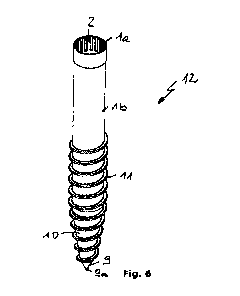Some of the information on this Web page has been provided by external sources. The Government of Canada is not responsible for the accuracy, reliability or currency of the information supplied by external sources. Users wishing to rely upon this information should consult directly with the source of the information. Content provided by external sources is not subject to official languages, privacy and accessibility requirements.
Any discrepancies in the text and image of the Claims and Abstract are due to differing posting times. Text of the Claims and Abstract are posted:
| (12) Patent Application: | (11) CA 3157846 |
|---|---|
| (54) English Title: | METHOD FOR PRODUCING A SCREW FOUNDATION FOR SECURING ELEMENTS IN THE GROUND |
| (54) French Title: | PROCEDE DE PRODUCTION D'UNE FONDATION A VIS POUR LA FIXATION D'ELEMENTS DANS LE SOL |
| Status: | Examination |
| (51) International Patent Classification (IPC): |
|
|---|---|
| (72) Inventors : |
|
| (73) Owners : |
|
| (71) Applicants : |
|
| (74) Agent: | SMART & BIGGAR LP |
| (74) Associate agent: | |
| (45) Issued: | |
| (86) PCT Filing Date: | 2020-10-06 |
| (87) Open to Public Inspection: | 2021-04-22 |
| Examination requested: | 2024-04-22 |
| Availability of licence: | N/A |
| Dedicated to the Public: | N/A |
| (25) Language of filing: | English |
| Patent Cooperation Treaty (PCT): | Yes |
|---|---|
| (86) PCT Filing Number: | PCT/EP2020/077904 |
| (87) International Publication Number: | WO 2021073927 |
| (85) National Entry: | 2022-04-13 |
| (30) Application Priority Data: | ||||||
|---|---|---|---|---|---|---|
|
The invention relates to a method for producing a screw foundation (12) for securing elements in the ground, in which a cylindrical tube (1) is provided as an initial form and a conical front portion (10) tapering to an insertion tip (9) is then moulded on to the cylindrical tube (1) by means of a non-cutting process, the front portion (10) being provided at least in some regions with a thread-like contour (11) for screwing into the ground. According to the invention, an inner contour (2) for a screwing tool is formed integrally in a rear end (1a) of the tube (1) by flow forming, and the front portion (10) and the thread-like contour (11) are formed exclusively by flow forming.
L'invention concerne un procédé de production d'une fondation à vis (12) pour la fixation d'éléments dans le sol, dans lequel un tube cylindrique (1) est présenté comme une forme initiale et une partie avant conique (10) se rétrécissant vers une pointe d'insertion (9) est ensuite moulée sur le tube cylindrique (1) au moyen d'un procédé de non-coupe, la partie avant (10) étant pourvue, au moins dans certaines zones, d'un contour filiforme (11) destiné à être vissé dans le sol. Selon l'invention, un contour intérieur (2) pour un outil de vissage est formé d'un seul tenant dans une extrémité arrière (1a) du tube (1) par formation d'écoulement, et la partie avant (10) et le contour filiforme (11) sont formés exclusivement par formation d'écoulement.
Note: Claims are shown in the official language in which they were submitted.
Note: Descriptions are shown in the official language in which they were submitted.

2024-08-01:As part of the Next Generation Patents (NGP) transition, the Canadian Patents Database (CPD) now contains a more detailed Event History, which replicates the Event Log of our new back-office solution.
Please note that "Inactive:" events refers to events no longer in use in our new back-office solution.
For a clearer understanding of the status of the application/patent presented on this page, the site Disclaimer , as well as the definitions for Patent , Event History , Maintenance Fee and Payment History should be consulted.
| Description | Date |
|---|---|
| Letter Sent | 2024-04-23 |
| Request for Examination Requirements Determined Compliant | 2024-04-22 |
| All Requirements for Examination Determined Compliant | 2024-04-22 |
| Request for Examination Received | 2024-04-22 |
| Inactive: Recording certificate (Transfer) | 2023-09-29 |
| Inactive: Single transfer | 2023-09-21 |
| Letter sent | 2022-05-17 |
| Inactive: IPC assigned | 2022-05-11 |
| Inactive: First IPC assigned | 2022-05-11 |
| Priority Claim Requirements Determined Compliant | 2022-05-10 |
| Inactive: IPC assigned | 2022-05-10 |
| Application Received - PCT | 2022-05-10 |
| Request for Priority Received | 2022-05-10 |
| Inactive: IPC assigned | 2022-05-10 |
| Inactive: IPC assigned | 2022-05-10 |
| Inactive: IPC assigned | 2022-05-10 |
| National Entry Requirements Determined Compliant | 2022-04-13 |
| Application Published (Open to Public Inspection) | 2021-04-22 |
There is no abandonment history.
The last payment was received on 2023-09-20
Note : If the full payment has not been received on or before the date indicated, a further fee may be required which may be one of the following
Please refer to the CIPO Patent Fees web page to see all current fee amounts.
| Fee Type | Anniversary Year | Due Date | Paid Date |
|---|---|---|---|
| Basic national fee - standard | 2022-04-13 | 2022-04-13 | |
| MF (application, 2nd anniv.) - standard | 02 | 2022-10-06 | 2022-08-29 |
| MF (application, 3rd anniv.) - standard | 03 | 2023-10-06 | 2023-09-20 |
| Registration of a document | 2023-09-21 | 2023-09-21 | |
| Request for examination - standard | 2024-10-07 | 2024-04-22 |
Note: Records showing the ownership history in alphabetical order.
| Current Owners on Record |
|---|
| WINKELMANN FOUNDATION SCREW SP. Z.O.O. |
| Past Owners on Record |
|---|
| BERND RUDERT |
| KARL-HEINZ HECKER |
| RALF POTTGUTER |